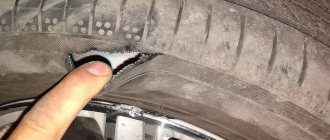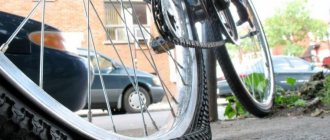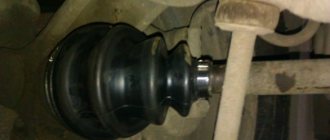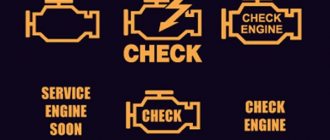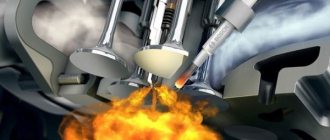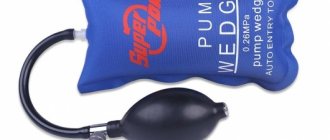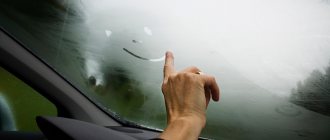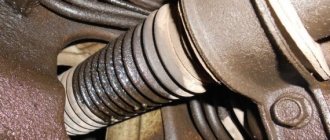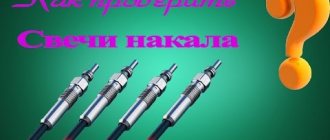Motorists have cleverly dubbed the swelling on the surface of a car wheel a “hernia.” But even an inexperienced driver, knowing what loads the wheels bear and how much they “get” from “high-quality” roads, seeing a hernia on the wheel of his car, asks the question - is it possible to drive with such a wheel?
Sometimes the size of the damage is very small and seems harmless, but the question still arises: is it possible to drive with a small hernia on a wheel? Considering the considerable cost of “rubber”, then maybe it makes sense to think about tire repair? And in general, is it possible to repair a hernia on a wheel? First, let’s figure out what the causes of such an annoying “wheel disease” are.
Tire hernia repair
Reading time: 6 minutes
Not all car tires are manufactured in accordance with quality assurance requirements and have the necessary certificates. In such cases, the thickness of the rubber layer may be uneven, and some part of it will wear out faster. Because of this, under the air pressure inside the wheel, this area undergoes deformation - a hernia occurs on the tire. Also, similar cases occur when the wheel is unbalanced or the alignment of the suspension is faulty. Regardless of the reasons, this problem signals danger during further operation of the vehicle.
What is a hernia on the wheel
A wheel hernia is the result of swelling of the tire rubber under the air pressure inside it. It occurs when one or more layers, most often located on the lateral surface, are damaged, which leads to weakening of this area and stronger stretching.
Hernia on the wheel
Hernia on a wheel: is it possible to drive and how safe is it to use?
Due to violations of operating rules, a tire rupture occurs, which is facilitated by the following factors:
- The first thing to avoid is driving over bumps and potholes, since with each impact the tire is subjected to a sharp surge in pressure from the inside, which leads to increased wear.
- The weather is too hot, as heating the rubber leads to its softening, which significantly weakens it and exposes it to rupture.
- On the contrary, cold weather with extreme temperatures, regardless of the composition of the rubber material, greatly affects its brittleness, and it is easier for the fibers to break under stress.
- Lastly, any long or too fast driving increases the friction force and, accordingly, heat, which can also cause an accident.
Is it possible to drive with a hernia on a wheel: what to do, how to remove it
Careless driving on a bad road can lead to deformation of the cord on a car tire, after which the side of the wheel is blown out in some place and a so-called hernia appears. We will talk about whether it is possible to ride on a wheel with a hernia in our article.
Since even the strongest tires on a vehicle have a limiting strength life, you should not expose it by driving onto a bad asphalt road at high speed. The consequences can be unpredictable, especially if the problem appears with the front steered axle of the car.
When do car hernias appear?
The side bumps on the tire are the result of the rupture of synthetic threads, which are one of the layers of automobile rubber. At the same time, the rubber itself, before it even breaks, stretches under air pressure, which finds weak points in the structure of the tubeless tire. Such a place looks like a lump or swelling on the human body.
There is no point in thinking for a long time about what to do with a hernia on the wheel. After all, this weak point has already demonstrated to the driver that there is a problem. Now it needs to be resolved as quickly as possible so as not to get a new one. A bulging lump does not always behave consistently. Most often, its size increases at different rates.
The most popular cause of this problem is a wheel falling into a deep hole on the asphalt while driving fast. In fact, the tire, under the influence of the entire mass of the car, crashes into a rigid obstacle at high speed, which is the opposite side of the pit. A sharp angle crashes into the slope and, if the rubber can withstand it, the cord inside breaks.
A wheel hernia repair may also be required for lateral injuries. This happens during the interaction of the slope with destroyed curbs and parts of metal reinforcement protruding from there or sharpened stones lying on the side of the road.
Possible formation due to partial abrasion of rubber from the side surface. This can happen without a sharp blow, but with heavy load and friction against hard objects that act as an abrasive.
During an accident, the impact may also fall on the wheel. This can also cause the formation of a hernia in such a place. This impact can tear the cord that forms the frame and shape of the tire.
Driving with a bump on tires
Long-term driving with a hernia on a wheel, no matter the size of the damage, is not recommended. This is especially dangerous at high speeds. The most problematic are swellings on the front wheels. Before removing a hernia from a wheel, you need to know that the most problematic bulges are considered to be formations larger than 10-20 mm.
If possible, move the damaged slope with a slight swelling to the rear axle.
The resulting beating and emerging imbalances can lead to dire consequences. The greatest negative will happen in a situation where the problem is on the front axle. A car with an already burst tire will become uncontrollable.
The resulting beating can sometimes even be felt through the steering wheel. Also, long-term driving with such a hernia damages the bearings in the hub and weakens the suspension.
During movement, the wheel heats up, which leads to overheating, and accordingly, even more blowing out of the lump. Braking in such a situation can lead to a rupture at a weak point in the tire. Getting into a hole again even at low speeds can lead to this result.
What actions need to be taken
It’s good to have a prepared and inflated spare tire in your car. It must be installed immediately in place of the damaged wheel. If the trunk is empty, then remove all bumps to the rear axle and drive slowly, stopping regularly and checking the condition of the damage. Not every hernia can be repaired, so whether the damage can be repaired will be decided by tire specialists in each case individually.
If the car is overloaded, then it is advisable to reduce the total weight by transferring the cargo to another car, as well as transferring passengers to another type of transport moving in the same direction.
Possible technologies for repairing cones
Minor damage on expensive slopes can be repaired with internal patches. This procedure will not give a 100% guarantee, but it will increase the service life of the problem wheel if you handle it carefully before purchasing a new one.
Repair begins with cleaning and degreasing the surface to be treated. Next, a vulcanizing compound containing raw rubber is applied. Then a patch is placed and vulcanized. This method helps to strengthen the problem area, however, it does not restore the main damaged threads.
The strength characteristics after repair increase, but do not reach the values that were before the hernia appeared.
Sometimes a tube is mounted into a damaged tire, but this also does not provide maximum strength to the wheel. After any of the options for correcting the damage, it is necessary to balance the wheel.
Conclusion
The option of “treating” a wheel with a herniation at the station will be quite expensive, so it will be ineffective for budget tires. For any wheel, it will not be possible to fully restore strength to its previous level. In any case, you need to prepare to buy new tires, because repairing a wheel with a hernia will only delay its complete unsuitability.
Interesting on the topic:
ktonaavto.ru
The process of repairing a wheel with a hernia
A professional, having received a wheel with a similar defect for work, during its restoration follows the algorithm below:
- He dismantles the wheel, washes it and carefully examines it for the presence of deformations, which can be both on the external side, visible to the eye of the car owner, and on the internal side.
- Next, the technician removes the rubber from the rim, having previously marked the areas with defects with a marker or chalk.
- The damaged area must be carefully removed using a special rubber knife and scissors.
- From a whole tire, craftsmen prepare in advance rubber reinforced flaps, which later become patches for such cases. The most popular material donors are tires discarded by owners after mechanical damage rather than wear.
- All edges of the hole resulting from cutting must be processed with a special rotary machine with abrasive in order to get to the inside of the multi-layer coating of the product.
- To work with such defects, the craftsman must have a special substance on hand - rolled raw rubber, with which they fill the defect by gluing it over the entire area of the hole.
How to Remove a Small Radial Bump on a Rear Tire
There is a bump on the side of the wheel, what should I do?
- First you need to stop and inspect the tire for the danger of this defect for further operation of the vehicle. In order to soberly assess the situation, the driver should simply press on the hernia, and if it is hard enough, then the car owner has the opportunity to drive to a tire shop and change the wheel.
- If the bump on the wheel is soft, further movement of the car is fraught with risk. The problem must be eliminated either by replacing the wheel with a spare wheel, or repairing a herniated tire right on the road.
- The car must be jacked up, after which the wheel is removed and placed flat.
- The car enthusiast should have a patch on hand, since without it the procedure is impossible.
- The tire is completely relieved of pressure, but since it is not under load, the wheel will not deform under its own weight.
- The cone is carefully cut out with a knife, and then the surface of the edges around it is carefully processed and degreased.
- A patch of a suitable size is taken, after which both the tire itself and the rubber flap are treated with glue. If the material is not at hand, it is not possible to repair the product.
- The flap is pressed against the splint and remains in this position for 30...60 minutes.
- After the driver has managed to repair the product, pressure is applied to the tire, and the car enthusiast checks whether the wheel is leaking air.
- If the patch turns out to be airtight, the driver will be able to ride the wheel several tens of kilometers to the nearest service station.
Is it possible to repair tires with a hernia?
Drivers should understand that it is impossible to completely cure a hernia. Return the wheel to its previous characteristics (strength and reliability will not work). But you can try to patch up the damage for a while. Before starting the procedure, it is necessary to degrease the surface of the tire and clean it. After this, restoration occurs in one of the following ways.
- Patch. First, a special rubber-based adhesive mixture is poured on the inside. Then a reinforced patch is applied and vulcanized. The size should be selected so that it is slightly larger in size than the hernia. This will allow it to stick to the slope without damaging the threads.
- Rubber. To create an artificial patch, a piece of rubber without a reinforcing layer is cut out of the chamber and then glued to the hernia. This method is cheaper than the first, but not as reliable and effective. It allows you to increase the strength of the slope, but disrupts the balance and uniformity of the coating.
- Nylon threads. The hernia is firmly tightened with nylon threads, and a rubber layer is soldered on both sides. The method is considered the most short-lived.
All of the above methods are only a temporary solution to the problem; sooner or later you will have to change the tire. And if the hernia is large, they may be useless.
To further reduce the likelihood of a hernia, you should consider the vehicle's operating conditions before purchasing tires. Information about the profile height and maximum load is applied to their side surface. A wise choice will allow you to avoid additional expenses for eliminating hernias and other minor repairs.
Operating a car after repairing a herniated tire
Even after repairing the hernia, the wheel still needs to be changed at the first successful opportunity, because it will no longer be able to maintain the specified pressure for a long time, and its behavior during further operation will be unpredictable. This means that even if after applying the patch the driver does not notice a loss of pressure in the wheel, he will almost certainly encounter the following problems:
- Uneven distribution of masses in the wheel after repairing tire bumps, which will inevitably lead to imbalance while driving. For such cases, it is recommended to have the tire balanced at the nearest car service station, where technicians will try to balance the products using lead weights, taking control measurements on a special stand.
- If the wheel hits the steering wheel too hard, the vibrations can damage the hubs, bearings, brake system, shock absorbers and ball joints. In addition, operation with such a defect often leads to a violation of the wheel alignment, uneven wear of the wheel and the friction component of the brake pads.
- After the repair, the driver will not be able to drive quietly for long distances, since the wheel may become depressurized at any time due to a rupture or peeling off of the patch. So, every 10...15 kilometers he must stop, get out, conduct a visual inspection of the wheel and check the pressure in it using a pressure gauge on the compressor.
Hernia on a wheel: is it possible to drive and what to do about it?
A one-sided swelling of a car tire is commonly called a hernia. Typically, a hernia occurs as a result of damage to the inner layers of the tire. The consequence of this may be wheel runout, since when the tire swells, its balancing is disrupted. Repairing a hernia on a wheel is not always possible, but even after repair, it is usually not possible to completely restore the properties of the tire.
However, a tire with a herniation can be partially repaired and can only be installed on the rear axle or used as a spare wheel.
At the end of this article, watch a video with tips on how to deal with tire hernias, and what to do if the tire swells while traveling.
The motorist should also be aware that if the side bulge is large, many tire shops will most likely refuse repairs.
What to do and can it be repaired?
The question is not easy; you can assess maintainability yourself, and quite quickly.
- If there is more than one bump on the surface, say two or three. There is no point in repairing anymore
- If the hernia is more than 2 cm in height and width, then repair also does not always make sense
- If it is 2 cm or less, then it can be considered for repair
The point here is this, 2 cm, this is not such a big breakthrough, most likely several strands of cord were damaged, and you can try to repair this place.
The repair is carried out as follows: a special radial patch (or patch) is glued from the inside or better yet, vulcanized. It has threads inside that will prevent the bump from expanding. Moreover, the “patch” must be installed strictly according to the arrows, usually radially.
If the hernia on the surface of the tire is more than 2 cm, say 5 or more, you can try to restore it, but it is not always advisable.
Firstly, a large patch will be needed, usually for freight transport. And it’s heavy, which will throw off the wheel’s balancing (“you’ll need to hang a lot of weights”)
Secondly, too much of the area is torn and it’s not a fact that the patch will fix this problem, because you can’t look into the middle of the rubber
Causes of a hernia on the wheel and its consequences
A hernia on the wheel can appear for a number of reasons.
- Violation of tire manufacturing technology. Most often, the defect appears in the first year of operation.
- Potholes on the roads and driving on curbs. Depending on the shape and size of the hole (curb), as well as on the speed of the car and the quality of the tire, a “bump” of a certain size is formed.
- Side cut. A bulge on the side surface also appears after a tire is cut, or after the wheel rubs against a curb.
- Road accident. A hernia can also result from a car accident if a strong blow hits the wheel.
How does a tire bulge form? Yes, very simple. The tire is a multi-layer structure: it has a frame (made of metal cord), a textile layer, a bandage and a tread.
When a wheel falls into a deep hole while the car is moving, a “breakdown” of the tire to the disk occurs. The tire is completely compressed and pressed firmly between the wheel rim and the asphalt for a split second. This damages the fibers of the textile layer, which are located inside the side of the wheel.
Since the rubber is soft and elastic (in the side surface of the tire), a pressure of 2-2.5 atmospheres from the inside squeezes out the hernia in the place where the integrity of the fibers is broken. The size of a wheel hernia is determined by the design of the tire and the number of torn fibers in its textile layer.
Is it possible to drive with a hernia on a wheel?
At first glance, a lateral tire herniation is not a critical defect that affects driving safety. However, when driving a car with a damaged tire, the following negative phenomena occur:
- Wheel runout, which leads to rapid wear of the wheel bearing and suspension parts;
- Tire heating;
- Increased tire pressure.
A tire with a herniation can burst when the load on the wheel increases in many cases. Here are just a few of them:
- At high speed.
- As the weight of the vehicle increases.
- During emergency braking.
- The next time a tire hits a hole.
- When driving on uneven roads.
Therefore, you need to take this type of wheel damage responsibly, especially since tire manufacturers categorically prohibit driving on tires even with small hernias.
Experience shows that tires, even with minor hernias, often burst while driving. As a result, there is a risk of the vehicle getting into an emergency situation.
What to do
If a hernia appears on a wheel, it is recommended to immediately remove the tire and replace it with a new one. Not every car enthusiast has a spare tire in the trunk, so to continue driving, you can contact a car service. If this is not possible, but the use of a vehicle is necessary, you should adhere to certain recommendations.
- If the front wheel is damaged, it should be removed and installed on the rear axle. This will allow you to maintain partial control of the vehicle and distribute the load evenly.
- Then you need to lower the pressure in all tires.
- You need to be extremely careful when driving a car with damaged tires. You cannot develop high speed or make sudden stops. The speed must be sufficient so that in the event of a tire break, the driver has time to react and control the car. Otherwise, there is a high probability of getting into an accident. When moving, you should avoid potholes to prevent sudden impacts and overheating of the rubber.
- While driving, it is recommended to make short stops and inspect the tires. This will determine whether the lump is increasing in size.
- Do not overload the vehicle. If possible, it is better to avoid carrying a large number of passengers.
Many motorists drive with a herniated wheel for a long time without paying attention to them. This cannot be done; at the first opportunity, the driver must contact a tire shop.
Methods for repairing a hernia on a wheel
Many domestic tire shops provide repair services for wheel bulges. But not every case can be repaired. During repair, it is impossible to restore damaged fibers and threads. No one will be able to return their high factory strength.
The workshop will most likely install a patch at the site of the hernia using the vulcanization method. It is best if it is reinforced. Such repairs will allow you to reach your final destination.
After repair, the geometry, weight and balancing of the tire change. The uniformity of the tire in terms of rigidity is also disrupted. Even after repair, a small bump will be squeezed out in the damaged area.
The cost of repair, depending on the size of the hernia, ranges from 1000 to 5000 rubles, which is often comparable to the price of used tires.
It is not always possible to eliminate wheel runout by balancing after repairing a hernia. Therefore, installing such a wheel on the front axle is quite dangerous. Even if the tire does not rupture, the steering rack, wheel bearing, shock absorber, silent blocks, ball joints, etc. will be subject to increased wear during driving.
In some cases, a tube is inserted inside the damaged tire. However, the absence of reinforcing fibers in the chamber does not lead to an increase in the rigidity and strength of the wheel. In addition, the wheel balance is disrupted and the likelihood of the tire heating up increases.
How to remove a hernia on a car wheel and why it is dangerous
Cord threads are the basis of the tire's power frame. When the reinforcing component ruptures, an oblong or round bulge appears on the side surface of the tire, and sometimes on its tread, which is called a “hernia.”
At first, the defect is barely noticeable, but under the influence of internal pressure it becomes larger. As a result, the tire pressure drops in proportion to the size of the problem, creating the risk of tread separation and tire explosion while driving at high speed.
Causes of hernia
The swelling of the elastic rubber shell on the sides of the ramp occurs under the influence of air pressure in the cylinder. The main and only reason for the phenomenon is the rupture of the internal threads of the textile cord, which acts as the strength frame of the tire. When its integrity is compromised, the air stretches the rubber and a “bump” appears.
Destruction of the cord on the side parts and radial herniation of the wheel occurs for the following reasons:
- Peak load in the form of a strong impact on the slope, exceeding the tensile strength of the textile frame. Most often, this is when a wheel falls into a hole with sharp edges at high speed.
- The same applies when hitting a hillock or curb.
- Damage to threads due to side cuts from sharp objects.
- A combination of two factors: overloading the car (or trailer) and driving on uneven roads.
- A manufacturing defect, sometimes found on cheap Chinese-made products.
The “bump” very rarely swells on the working part of the ramp that comes into contact with the road. This is explained by the design of the tire: the tread is protected not by textile, but by metal cord, which is much more difficult to destroy. The load from the impact is transferred to the sidewalls and the threads break, in some cases on both sides.
The location of the hernia depends on the location of the damage to the frame. Often the “bump” jumps up near the rim itself or in the middle of the side plane. It's worse when the bulge forms close to the tread and changes its shape. Contact with the road surface accelerates the destruction of the cord and quickly leads to rupture of the casing - the tire “shoots”.
What can cause a hernia to appear on a wheel?
The cause of the defect may be a manufacturing defect if, during the manufacture of the tire, an air bubble accumulated between the rubber and the cord fabric during vulcanization or a distance was allowed between the threads that exceeded their thickness.
In such cases, the hernia becomes noticeable after installing a new tire or shows itself during the first 12 months of use.
The reason for the appearance of a defect is the actions of the driver and external circumstances:
- hitting a curb slab;
- a wheel falling into a hole while driving at high speed;
- rubbing against the curb, sliding contact of the side surface of the tire with a hard object;
- driving on the railway track;
- violation of manufacturer’s parameters regarding maximum speed and load norm;
- hitting a wheel during an accident;
- a cut on the side surface by an edge of ice, damage to it by a sharp corner of a stone or a metal object.
The prerequisites for the formation of a hernia are created by violations committed during the installation of tires.
For example, installation on a disk for tubeless tires, deformation of the bead ring during work, use of non-standard tools or equipment during installation.
Reasons for education
A modern tire has a multi-layer structure. Usually the appearance of a bump occurs due to the rupture of the synthetic threads of one of the layers. At the same time, the rubber itself remains intact, so in tubeless tires the air presses through the weak spot, thereby forming a bump. This place is immediately easy to detect, since it protrudes significantly relative to the sidewall of the tire.
There can be many reasons for damage to the layer of synthetic threads. These include:
- side tire cut;
- vehicle falling into a deep hole at high speed;
- too much tread wear;
- hitting a tire when involved in a traffic accident;
- initial defect in the tire due to a violation of production technology.
The condition of most roads leaves much to be desired, so there are often cases when protruding pieces of reinforcement or road debris can become a direct cause of a hernia on a wheel.
Is it possible to drive with such a defect?
Experts compare a hernia to a time bomb. What are the dangers of a bulging tire?
- Wheel imbalance. A runout appears, which breaks the bearing and negatively affects the suspension silent blocks, shock absorbers, and ball joints. A flawed front wheel causes damage to the steering components due to runout.
- Increase in size of the defect. The hernia grows as a result of rupture of the cord threads under the influence of the internal pressure in the tire, driving speed, vehicle load, or driving on a bad road.
- A sudden accident. Even a slight bulge indicates that the tire has lost a sufficient level of strength. During acceleration, driving at high speed, sudden braking, or a wheel falling into a hole, the tire may burst.
Driving a car with a defective wheel is dangerous. If a herniation is found on the tire, then it is best to remove the damaged wheel and install a spare one.
If it is not possible to replace it, it is worth slightly reducing the pressure in the wheel and moving it to the rear axle in order to improve the controllability of the car in the event of a tire break. You need to continue the journey at a slow speed and have the wheel replaced or repaired at a tire shop.
Are there any tires that are resistant to herniation?
You can protect the wheel from the formation of a hernia when choosing a tire. The quality of the rubber that makes up the tire, as well as the production technology, directly affect the resistance to hernia. There are known cases when cheap tires were deformed not from overloads or strong impacts, but during inflation. Therefore, it is not worth saving on tires. Most likely, such tires will have to be changed or repaired soon. Such savings can end up costing much more. Not to mention the danger to the driver and other road users
When buying tires, you should first pay attention to tires with additional load weight. There is a special load index indicator for this.
The higher its number, the more reliably the wheel will be protected from the appearance of unwanted hernia. Some brands use the additional designation XL (extra load). This means that the tire was specially designed to work under heavy load conditions. Such a tire will undoubtedly last much longer. You should be especially careful when buying tires secondhand. The fact is that it is impossible to determine whether there is a hernia on the tire until you inflate it. Therefore, when buying used tires, there is a high risk of purchasing an unusable tire that cannot be repaired. Irresponsible motorists often do not pay attention to the fact that there is a herniation on the wheel, and continue to drive until the tire bursts or is severely deformed. Thus, the driver endangers not only himself and his passengers, but also other road users. If at high speed a wheel with a herniation falls into a hole, then most likely it will rupture and the car will lose controllability. Such careless attitude can lead to serious consequences.
Options for repairing bumps on the wheel
The answer to the question whether a hernia can be repaired depends on the location of the defect and its size. If the tire bulge is located closer to the bead than 40 mm or is large in size, then the tire is considered unrepairable .
To troubleshoot other problems, use 3 methods.
- Install the patch. A reinforced rubber patch or patch is glued by vulcanization to the damaged area from the inside of the tire.
- Reduces pressure on the problem area. To do this, place a tube inside the tire or lay a piece of thick rubber.
- Perform a screed. The edges of the defect are tightened with nylon threads, then the area is vulcanized using raw rubber.
A more reliable option for eliminating the “bump” is to install a reinforced patch, but it, like other methods, does not restore the previous level of strength and reliability of the tire. They can only be considered as a temporary measure.
How to operate a car after repairing a wheel herniation
After restoration work, you need to move the wheel with the repaired tire to the rear axle, perform balancing, and follow several rules while operating the car:
- maintain tire pressure slightly below normal;
- avoid potholes and bad sections of roads;
- avoid sudden braking, acceleration, and wheel impacts;
- drive at a speed that, if a tire breaks, will provide the opportunity to quickly react to the situation and stop the car;
- load the vehicle below the permissible limit;
- Inspect the wheel regularly. If a tendency towards an increase in the defect is detected, take decisive action.
Is it possible to repair a hernia on a wheel: how to drive after that
Hello, dear motorists! Tires are an integral part of any car. And problems with them are not uncommon. Today we’ll talk about the phenomenon of a hernia on a wheel and whether it is possible to repair such a malfunction.
A hernia is a lateral, or one-sided, swelling on a car wheel.
There are several reasons for its appearance. This is typical not only for cars, but also for a motorcycle, sometimes even a baby stroller.
Today we’ll talk about why it appears, what consequences it can lead to, and what to do in general if a hernia forms.
Is it possible to ride with a bump on a bicycle tire?
If a hernia appears on a tire, you should carefully inspect the tire. If the lump is small, it can be patched with thick leather. Over time, the damage should decrease or disappear completely.
It is recommended to feel the hernia. It can be soft or hard. If it is hard, then the problem is due to severe damage and the cord has burst. In this case, you can try to patch or change the tire. In the case of a soft lump, the problem may be the lack of a camera. Air penetrates between the cord and the rubber, which could cause the latter to peel off. In this case, it is recommended to wear cameras. The bumps should go away.
How and why it appears
Let's start with the fact that the hernia itself comes in two types.
This is radial, which appears on the tread, or longitudinal, where the side part of the tire suffers. Radial swelling occurs much less frequently, since the rubber in the tread area is much stronger and more resistant.
Therefore, we are mainly talking about longitudinal defects.
There are several reasons for their appearance on the front or rear wheel:
Now to the question of how this bulge appears on the side of the wheel. Everything is quite simple here.
As you know, a tire is a multi-layer product; there is a frame, a layer of textile material, a bandage, and a tread. If, while driving, the wheel ends up in a hole, a so-called tire breakdown occurs all the way to the disc. The tire compresses and may come into contact with the rim and asphalt. At this moment, damage occurs to the fibers and layers located inside the structure.
The rubber itself is quite elastic and soft. Especially from the side. Pressure is applied to it from the inside, thereby blowing out the hernia in the damaged area. How not to remember about tire pressure and standard indicators.
Bump on a bicycle tire - reasons
In order not to damage the tire and prevent the appearance of a bump, you need to:
- Mount the wheel carefully, do not pinch the surface from the side. Do not use cutting tools.
- Inflate the tire to the level required for the selected wheel.
- Monitor the wheel parameters: rubber tension (strong or weak), formation of folds in the inner material.
- It is recommended to pay attention to the valve nuts near the chamber when inflating. The nuts must be tightened periodically.
- The internal pressure should be suitable for the purpose of driving: on asphalt the wheel is well inflated, for off-road use - less.
- Sharp corners, stones, iron rods can damage the wheel when colliding. It is advisable to immediately patch any damage and clean the tire of debris.
- If there are patches, the bike is not recommended to be used in extreme conditions.
- Before long-term storage, to extend the life of the tire, it is recommended to lubricate it with a special liquid product or glycerin.
The appearance of a bump on a tire may be due to a manufacturing defect or damage to:
- After hard braking.
- From a tire bruise (while driving over a hole or rocks).
- Due to using the tire for too long.
- Due to excessive weight load on the bike.
- Due to incorrect tire pressure when driving.
- A cut can also cause a bump.
To go or not
Initially, it may seem that a small hernia cannot in any way affect the safety of movement.
But if you continue to move in this state of the wheel, then the following will occur:
- heating the tire;
- wheel runout, accelerating wear of hub bearings and suspension;
- exceeding normal pressure levels inside.
In fact, this indicates that the tire is capable of bursting from the load at any time.
Several factors increase the likelihood of a tire blowout:
- high speed;
- placing cargo in the car;
- emergency braking;
- another hit in the hole;
- driving onto the curb;
- driving on uneven roads, etc.
Frankly speaking, a self-tapping screw in a wheel is sometimes even better than a hernia. But this may be a subjective opinion.
Is repair possible?
Some believe that longitudinal and radial hernias can be repaired. In their opinion, you can take the tire in for repair and continue driving it until the tread wears off completely.
Many domestic service stations actually undertake to repair swollen tires. But the result is not always justified.
Even with the highest quality repairs, the threads and fibers of the tire are not restored.
In fact, there is no need to talk about returning to factory strength.
Usually, during repairs, a patch is applied and the tire is vulcanized. This is the only repair option. And then, purely to get to your destination or tire store.
Repairs affect geometry, balance and weight changes. The uniformity of wheel stiffness also changes. For such repairs they can ask for from 1 to 5 thousand rubles. And this is the cost of a set of used tires.
Repair is theoretically possible. In practice, this doesn't really do anything.
